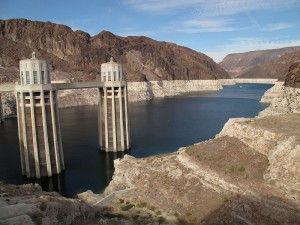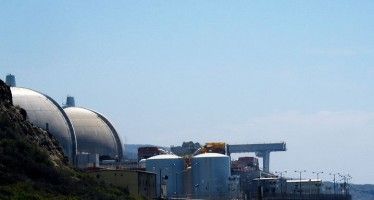Policy, not shortage, causing water crisis
Nov. 26, 2012
By Wayne Lusvardi
There is no apparent drought of journalists with metaphors to define the so-called water crisis in the United States and California. Every month, it seems, another new end-of-the-world water book comes out.
Cynthia Barnett is the author of the book, “Blue Revolution: Unmaking America’s Water Crisis.” In the Los Angeles Times, she recently wrote an op-ed, “America’s Water Mirage.” After visiting Hoover Dam with her daughter, Barnett’s sudden insight was, “[E]ven at Hoover Dam, the ugly truth about our water crisis is being ignored.”
Barnett’s article displayed a photograph of the “bathtub ring” around the rim of Lake Mead on the Colorado River showing evidence of “misuse of this precious resource.”
The problem is that the imagery doesn’t square with the reality. Lake Mead is part of the Colorado River system that has shown great variability in water levels over the last 100 years. A picture of the side walls of Lake Mead or Lake Powell showing water levels have dropped from their peak doesn’t tell us much of anything. The level of water in the system of dams that make up the Colorado River system has been rising and falling for half a century. And the ups and the downs mostly offset each other.
Conservation Ethic
The ignored problem here in California is that the “conservation ethic” that Barnett calls for has been mostly tapped out. It is granted that water conservation has been successful in California ever since 1982, when voters turned down the proposed Peripheral Canal Project. Population has grown about 59 percent since 1980. No new dams or reservoirs have been added to the state’s water system since then.
But the era of water conservation has mostly run dry by design, not drought. According to Bob Johnson, a water consultant retired from the U.S. Bureau of Reclamation, this has left California with only a six-month supply of water.
California has spent $18.7 billion on five water bonds since 2000. These bonds funded mostly open space acquisitions and landscaping projects that captured no new water and built no new reservoirs.
Those bond funds could have funded the proposed $13 billion Delta Tunnels. Or they could have funded both new reservoirs proposed as part of the $11.1 billion Consolidated Water Bond to appear on the 2013 ballot. Instead the bond monies have been mostly squandered. Water bonds have been partly turned into a slush fund for the state Legislature to redistribute Cap and Trade taxes among other activities.
Another green water project failure is Sen. Dianne Feinstein’s $1 billion San Joaquin River Restoration Project. The project has been turned into a wealth redistribution scheme that Congress refuses to continue funding beyond the $88 million allotted for environmental studies. Even if funded, all this project would do is take water from farmers and give it to commercial fishing, tourist hotel-motel developers and real estate enterprises.
On top of losing water, farmers would have to pony up a tax to pay for the projects that would benefit those who get the water from the politicians.
In her book, Barnett doesn’t mention the outcome of the infamous Delta Smelt court case in California. From 2007 to 2010, this environmental protection case shut down water deliveries to Southern California and some Central Valley farmers. The presiding judge ruled the science on which the case rested was “bogus.” During the “man-made drought” from the water shutdown, Southern California cities enacted water conservation ordinances, hired an army of water police, and raised water rates 15 percent or more. When the water shutdown order expired, and Brown officially declared the “drought” over, no cities or water districts repealed their water rate increases.
Water Conservation is Bad for Your Aquifer
Barnett’s “Blue Revolution water conservation ethic” advocates stopping the depletion of aquifers and halting large water projects.
Here she is uninformed about how aquifers work. They are mostly drawn down during dry years. And most urban aquifers in California are adjudicated by state courts and can’t be “depleted” beyond their safe yield, except possibly by urban water conservation efforts.
David Powell, former chief engineer for the California Department of Water Resources’ San Diego Office, paradoxically has demonstrated that urban water conservation actually depletes local aquifers and costs an astronomical $1,083 per acre-foot of water saved. Current water rates are about half that for the Metropolitan Water District of Southern California.
Stopping large water projects in California has about a snowball’s chance in Death Valley. This is because the electorate has turned into a Fusion Party for unchecked taxation and the governor has endorsed the Delta Restoration Project and Tunnels.
Can Big Water Projects be Financed?
The politics of water conservation in California has failed to be sustainable. The only likely thing that would stop the proposed Delta Restoration and Tunnel Projects now is red ink. There are no assured commitments yet for financing the Delta Restoration unless farmers pay for most of it. And farmers are only willing to pick up most of the tab if they can in return get “regulatory assurance” of no shut downs of water by lawsuits for 35 years. Good luck with that in Green California.
The only other alternative is for urban water districts to raise water rates by an estimated $240 per year per household (assuming 25 percent share of costs by farmers and no federal funding). But there would be no guarantee of how much water Southern California would be entitled to for that hefty price tag.
The possibility that Congress would fully fund California’s package of water projects — as it did in the 1930’s Great Depression — is dead, given a Republican-controlled House of Representatives and the federal Fiscal Cliff. It is not yet clear what Democrats would be willing to give up to get the Republican House to vote for the federal share of the cost of the Delta Restoration Plan.
So if voters, farmers, or urban ratepayers and the House are unwilling to pop about $53 billion for the total package of the Delta restoration, tunnels, dike repairs and ecosystem restoration, California would have to continue with water conservation even in wet years. The state’s 20/20 Water Conservation Plan calls for a 20 percent reduction in water use by 2020.
Contrary to Barnett, most of any continued conservation will come from farmers, not urban or industrial users. Barnett is still living in 1982, when the Peripheral Canal got shot down by voters.
Related Articles
At Last, California Ties Texas
Wayne Lusvardi: It seems that, since 2006 when the University of Texas Longhorns football team beat USC in the Rose
Bad weather: I want my tax money back!
Aug. 17, 2012 By John Seiler The only reason anyone in his right mind lives in California and pays massive
Costly fallout from San Onofre’s decommission
The Nuclear Regulatory Commission held a public meeting Thursday in Carlsbad, during which members discussed the process by which the




